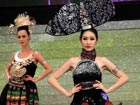| Videos | ? Latest |
|
? Feature | ? Sports | ? Your Videos |
China National Costume Design Contest wraps up in Guiyang

 0 Comment(s)
0 Comment(s) Print
Print E-mail
CNTV, December 1, 2011
E-mail
CNTV, December 1, 2011
54 of the 56 ethnic groups in China can be found in Southwest China's Guizhou Province. But there is no need to fret about not being able to behold all the ethnic wonders at once, because the first Future Ark Cup National Costume Design Contest plans to bring its winning ethnic costume designs to the masses.
 |
|
Renowned designer Lin Xuefei wowed the audience with her set of gowns inspired by Buyi, Miao, Dong, Mao'nan and Tujia Minority groups. |
The design contest, preceded by the first Minority Model Contest, wrapped up on Monday night in Guizhou's capital, Guiyang. Culture Express' Julian Waghann was there to bring us this special story.
Twenty-five finalists from 14 different regions in China took their designs to the stage. Many of them are only in their early 20s. Their works, however, are steeped in tradition and coupled with an eye for what's trendy.
CCTV's Julian Waghann said, "The emphasis of the contest is not just on the indigenous elements, but combining the indigenous elements with modern designs.
Because the designs selected will actually be mass produced by local garment companies here in Guizhou. So the clothes not only need to have this ethnic panache but also be very comfortable to wear. The models here have been wearing the costumes for a few days now through the rehearsals. Let's ask them what they think about the costumes."
Li Weishan, model, said, "It's very comfortable. These ethnic patterns and stitchings go well with evening gowns and dresses. I would definitely wear it out on special occasions."
Simple but rich, avant-garde and timeless, youthful yet inarguably elegant, are just few of the contradictions when it comes to describing these modern interpretations of ethnic classics.
Butterfly patterns breathe new life into this retro look with elongated lines. Others opt for the more geometric patterns and bold colors.
|
Chan Yixin, model-first place |
Renowned designer Lin Xuefei wowed the audience with her set of gowns inspired by Buyi, Miao, Dong, Mao'nan and Tujia Minority groups. In return, she got a little bit of surprise of her own!
Lin Xuefei said, "This award is not for me, but for Guizhou because I owe it to Guizhou for my inspirations. I traveled to many provinces in China and overseas to find the best way to integrate the ethnic elements and make them more fashionable."
Shen Jingyue and Wang Wenran received 3rd and 2nd places respectively at the contest. Also joining the celebration, are winners from the Minority Model Contest, which concluded four days earlier. The minority models come from all 56 minority groups in China including those in Taiwan Island.
Chan Yixin, model-first place, said, "This award is a great honor for me. Unlike other clothing, when you wear minority costumes you have to let its character come through. So you really need to understand the cultures behind them."
According to Ne Tiger's Designer Zhang Zhifeng, whose work had a cameo appearance at the event, the contestants are well conversant in fashion AND tradition.
Zhang Zhifeng, designer of NE Tiger, said, "These contestants understand where to find the roots. In other words, the ethnic elements and the use of new fabrics. They're seamlessly integrated."
In an effort to convert the wealth of Guizhou's cultural capital, with over 101 national cultural heritage sites and 2 world natural heritage sites, into "new industrial resources" and to stimulate the local economy, the province has created these contests to complement the region's tourism industry.
The province is planning on making these contests into an annual event. An assembly line of local garment companies is already in place to mass produce and distribute the selected designs. Soon, at Guizhou and hopefully elsewhere, culture will mean business.






